OpenInfra Live is a weekly hour-long interactive show streaming to the OpenInfra YouTube channel every Thursday at 15:00 UTC (9:00 AM CT). Episodes feature more OpenInfra release updates, user stories, community meetings, and more open infrastructure stories.
The 2021 User Survey shows that the footprint of OpenStack clouds grew by 66% over the last year, totaling over 25 million cores in production. This increase has been contributed by organizations of all sizes around the world. During this episode of OpenInfra Live, we are going to talk to operators from Kakao, Line, Schwarz IT, NeCTAR and T-Systems about what’s causing this OpenStack growth at their organization.
Enjoyed this week’s episode and want to hear more about OpenInfra Live? Let us know what other topics or conversations you want to hear from the OpenInfra community this year, and help us to program OpenInfra Live! If you are running OpenStack at scale or helping your customers overcome the challenges discussed in this episode, join the OpenInfra Foundation to help guide OpenStack software development and to support the global community.
For this week’s episode, we have five OpenStack users from four countries with one true passion for OpenStack, who came together to discuss the power of open infrastructure all around the world. Allison Price, Director of Marketing & Community at the OpenInfra Foundation, welcomed this episode’s speakers who are Andrew Kong at Kakao, Yushiro Furukawa and Reedip Banerjee at Line Corporation, Adrian Seiffert and Marvin Titus at Schwarz IT, Paul Coddington and Carmel Walsh at NeCTAR, and Nils Magnus at T-Systems.
Kakao:
As Korea’s number one internet mobile content service company, Kakao has 11 billion messages per month sent around the world, and it includes applications as such Kakao Games, Kakao Pay, Kakao Bank, and Kakao Mobility. Kaokao Cloud Platform (KCP) is running on OpenStack. Based on the OpenStack APIs, teams at Kakao developed Kubernetes service, container registry, deployment as a service and more.
KCP’s main strategy is to make the same usage pattern over the hybrid cloud. To achieve this goal, they created a hybrid connecting service, which uses OpenStack’s Keystone as a service provider and connects the private ID provider and public ID provider through the OpenID.
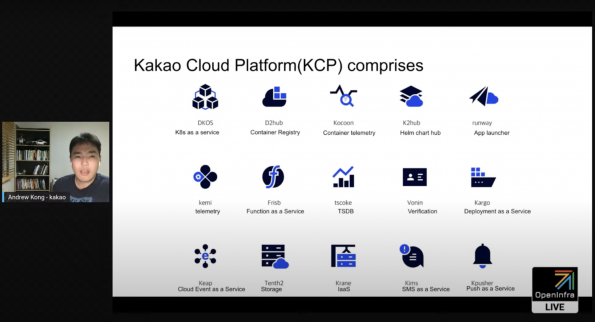
OpenStack cloud and development environment give more efficiency to develop and operate services at Kakao. Developers in Kakao can claim as much cloud resource as they want. They have modified and devised their OpenStack cloud to comply with compliances and regulations which accelerated developing cycles so much that they can build no-show COVID-19 vaccine reservations within 10 days.
With 200,000+ instances and more than 50,000 servers, KCP has expanded to six regions in the world and the growth rate is 30% year-over-year. Learn more about how Kakao is using OpenStack in its hybrid cloud environment in its case study.
Line Corp:
Starting to use OpenStack since 2016, Line is not only a messaging application but also a complete level of communication infrastructure. With around 189 million monthly active users and 4.9 billion daily messages, the scale of Line’s OpenStack environment has grown to 5,000+ hypervisors with 74,000+ virtual machines and more than 30,000 bare metal nodes.
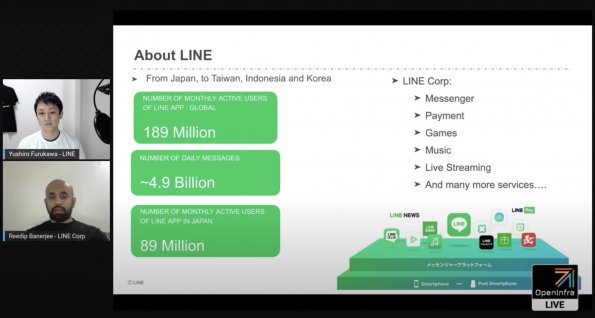
OpenStack has changed the service operation culture in Line’s development teams. The culture change has accelerated and supported Line’s service growth. OpenStack has also introduced an abstraction layer, a.k.a API, between actual data center infrastructure and application developers. The abstraction layer has changed Line’s service operation culture from “doing” operations to “developing” operations. The new culture has reduced lots of extra work and developers can focus on the service development now.
Learn more about how Line Corp is using OpenStack in its hybrid cloud environment and how its future OpenStack cluster growth looks like in its case study.
ARDC NeCTAR Research Cloud:
Australian Research Data Commons (ARDC), which operates the NeCTAR Research Cloud, supported by the Australian Government National Collaborative Research Infrastructure Strategy (NCRIS), provides Australia’s research community with fast, interactive, self-service access to large-scale computing infrastructure, software and data, and is a powerful platform for collaboration.
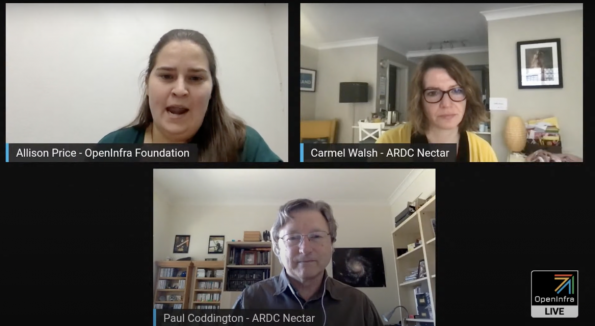
Since 2011, teams at the NeCTAR Research Cloud have been using OpenStack as their standard solution for open cloud infrastructure. OpenStack has enabled them to provide a cost-effective, large-scale research cloud infrastructure, federated across multiple organizations and locations in Australia and New Zealand. Since it is open infrastructure, they have been able to customize their deployments to meet the requirements of their user community, and leverage off, learn from and contribute to the international OpenStack community, and other research organizations that also use OpenStack.
Currently, the ARDC NeCTAR Research Cloud hosts more than 200 research platforms and services that are used by more than 50,000 researchers in Australia and internationally across all fields of research. For the scale of its OpenStack environment, it has 830 servers, 33,000 physical cores, and approximately 160,000 vCPUs across 7 sites.
Learn more about how ARDC NeCTAR Research Cloud is using OpenStack in its hybrid cloud environment and what’s next for its OpenStack deployment in its case study.
Schwarz IT:
STACKIT is the digital brand of Schwarz IT and thus part of the IT organization of Europe’s biggest retail group, which includes Lidl, Kaufland, and several production and recycling companies. By using OpenStack, STACKIT has started the internal transformation of the Schwarz IT to a cloud service provider. Enabling internal colleagues to order servers, storage and network configurations in a self-service and API-based way dramatically increased their speed. This is also covered by the high speed of resource provisioning which is now in the range of seconds instead of weeks.
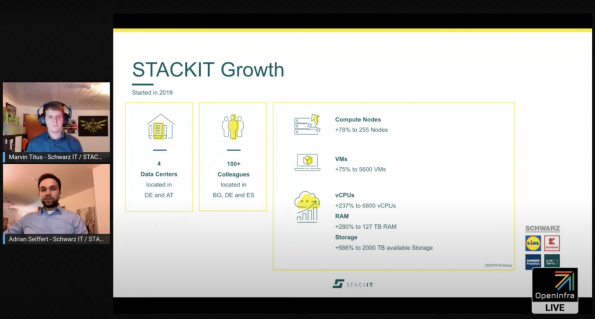
Teams at Schwarz IT started into the year 2021 with 180 compute nodes used by 5,000 virtual machines. Until now, they have close to 300 compute nodes and their virtual machines have increased by 20%. On these nodes, they provide 7,000 CPU Cores of different generations and around 140 TB of RAM. Their users transfer around 150 TB per month to and from OpenStack. Their environment is stretched over three separate data centers with dedicated fiber lines between them, which are utilized by their customers to transfer up to 11 PB of data per month.
Learn how Schwarz IT has been growing its OpenStack environment since 2019 in its case study.
T-Systems:
OpenStack enabled T-Systems to become a leading public cloud provider, conforming to the special needs of European legislation. Its open source approach made it possible to tailor the services conforming to our clients, who require transparency and security while being able to consume reliable and scalable services.
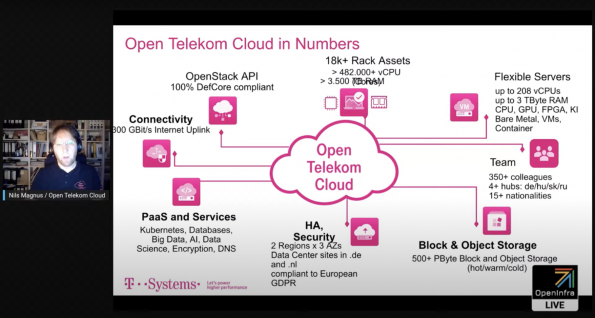
As a public cloud provider, typical IaaS services are the building blocks of its offering to its clients. That includes the OpenStack core services such as Nova, Keystone, Neutron, Glance, Cinder, Swift, and many more. On top of that, it offers many platform services like databases, Kubernetes frameworks, and AI services.
Distributed to two main regions with three availability zones each, its data centers currently host more than 6,000 servers and a similar number of other assets like switches, and security devices. Facilitating its network infrastructure, single instances are seldom more than single digit milliseconds roundtrip apart from each other, regardless of their availability zone; the total uplink exceeds several hundred GBit/s.
Learn about T-Systems International GmbH’s Open Telekom Cloud operated and its OpenStack environment in its case study.
OpenInfra Live: Keynotes
Enjoyed OpenInfra Live episodes? You will love OpenInfra Live: Keynotes, November 17-18!
This two day, two-hour per day, special edition of OpenInfra Live is your best opportunity to:
- interact with leaders of open source projects like OpenStack and Kubernetes to hear how the projects are supporting OpenInfra use cases like hybrid cloud
- gain insight into hybrid cloud economics and the role open source technologies play
- celebrate as we announce this year’s Superuser Awards winner.

Join us at OpenInfra Live: Keynotes to hear visionary experts discussing why specific deployments have crossed the million core threshold along with exclusive announcements, live demos, OpenStack + Kubernetes, and cloud economics!
Like the show? Join the community!
Catch up on the previous OpenInfra Live episodes on the OpenInfra Foundation YouTube channel, and subscribe for the Foundation email communication to hear more OpenInfra updates!

)







